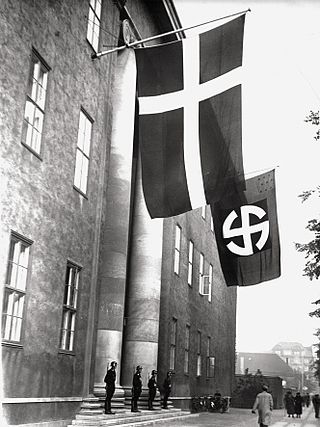
At the outset of World War II in September 1939, Denmark declared itself neutral. For most of the war, the country was an occupied territory of Germany. The decision to occupy Denmark was taken in Berlin on 17 December 1939. On 9 April 1940, Germany occupied Denmark in Operation Weserübung. The Danish government and king functioned in a relatively normal manner until 29 August 1943, when Germany placed Denmark under direct military occupation, which lasted until the Allied victory on 5 May 1945. Contrary to the situation in other countries under German occupation, most Danish institutions continued to function relatively normally until 1945. Both the Danish government and king remained in the country in an uneasy relationship between a democratic and a totalitarian system until 1943 when the Danish government stepped down in protest against German demands that included instituting the death penalty for sabotage.
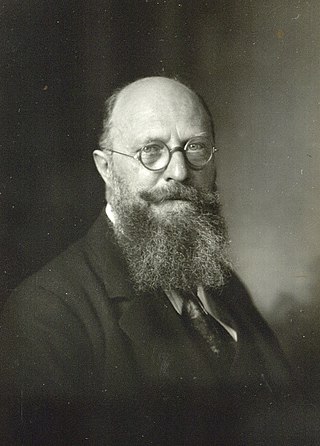
Thorvald August Marinus Stauning was the first social democratic Prime Minister of Denmark. He served as Prime Minister from 1924 to 1926 and again from 1929 until his death in 1942.
The Social Democrats is a social democratic political party in Denmark. A member of the Party of European Socialists (PES), the Social Democrats have 50 out of 179 members of the Danish parliament, Folketing, and three out of fourteen MEPs elected from Denmark.

The Danish Social Liberal Party is a social-liberal political party in Denmark. The party was founded as a split from the Venstre Reform Party in 1905.
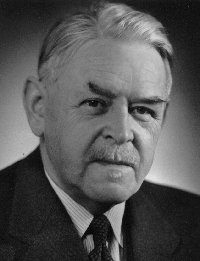
Vilhelm Buhl was Prime Minister of Denmark from 4 May 1942 to 9 November 1942 as head of the Unity Government during the German occupation of Denmark of World War II, until the Nazis ordered him removed. He was Prime Minister again from 5 May 1945 to 7 November 1945 as head of a unity government after the liberation of Denmark by the British Field Marshal Montgomery.

Karl Kristian Vilhelm Steincke, was a Danish politician from the Social Democratic Party. He was justice minister from 1924 to 1926 in the Stauning I Cabinet, social minister from 1929 to 1935 in the Stauning II Cabinet, and justice minister again from 1935 to 1939 in the Stauning III Cabinet and in 1950 in the Hedtoft I and II Cabinets. He has been cited as the chief architect of the Danish welfare state with the Social Reform Acts of the early 1930s, including the Kanslergade Agreement.

Folketing elections were held in Denmark on 24 April 1929, except in the Faroe Islands where they were held on 29 May. The Social Democratic Party remained the largest in the Folketing, with 61 of the 149 seats. Voter turnout was 79.7% in Denmark proper and 58.0% in the Faroes. Social Democrat Thorvald Stauning returned to the Prime Ministership by forming a coalition government with the Social Liberals, a position he would hold until 1942.

Alsing Emanuel Andersen was a Danish social democrat politician. Andersen served as the Minister of Defense (1935–1940) for Denmark. From 8 July 1940 to 1945, he served as the vice chairman of the Danish Social Democratic Party, and as the acting chairman of the party from the death of Thorvald Stauning until the end of the Nazi occupation of Denmark in 1945. Andersen briefly returned to national politics as the Minister of the Interior from 13 to 23 November 1947.
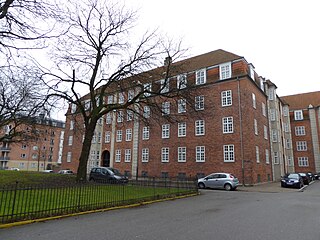
The Kanslergade Agreement was a 1933 political agreement in Denmark, which laid the foundation for the Danish welfare state. It was enacted by the government of prime minister Thorvald Stauning, with social minister K.K. Steincke being its chief architect. The Kanslergade Agreement was negotiated in Stauning's apartment on Kanslergade in Copenhagen, from which it takes its name.
Events from the year 1924 in Denmark.
Events from the year 1941 in Denmark.
Events from the year 1942 in Denmark.

Gunnar Nu Hansens Plads is a public space in the Østerbro district of Copenhagen, Denmark. It consists of a triangular plaza, located on the west side of Østerbrogade, just north of Parken Stadium, which turns into a wide street and continues for about 200 m to Fælledparken, The street then continues southwest as Per Henrik Lings Allé to Øster Allé. Several sports venues, some of which are listed, are located on the south side of the square. The former Østerfælled Barracks, now a mixed-use development known as Østerfælled Torv, are located on its north side.

The Scavenius cabinet was the government of Denmark from 9 November 1942 to 5 May 1945. It replaced the first Buhl cabinet, which collapsed due to the Telegram Crisis in November 1942, when the Germans demanded changes to the Danish government. The Germans wanted nonpolitical ministers and Nazi ministers in the new government, however only the first demand was met.
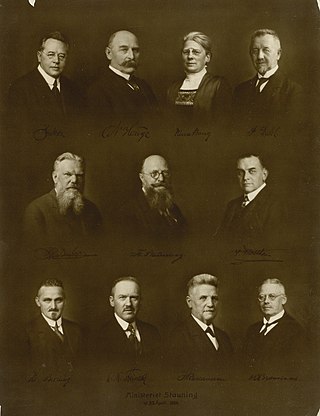
The First Cabinet of Stauning was the government of Denmark from 23 April 1924, to 14 December 1926. It was the first Social Democrats government on Denmark.

The Second Cabinet of Stauning was the government of Denmark from 30 April 1929 to 4 November 1935. It replaced the Madsen-Mygdal Cabinet, and was replaced by the Third Stauning Cabinet. This was the first coalition government in Danish history, consisting of the Social Democrats and the Social Liberal Party.

The First Buhl cabinet was the government of Denmark from 4 May 1942 to 9 November 1942. It was created following the death of Prime Minister Thorvald Stauning.

The Third Cabinet of Stauning was the government of Denmark from 4 November 1935 to 15 September 1939. It replaced the Second Stauning Cabinet, and was replaced by the Fourth Stauning Cabinet.
Harald Petersen (1893–1970) was a Danish politician who served as the minister of justice and twice minister of defence in the 1940s and 1950s.
Johannes Kjærbøl (1885–1973) was a Danish politician. He was a member of the Social Democrats and served at the Parliament from 1935 to 1957. He held various cabinet posts between 1935 and 1959.














